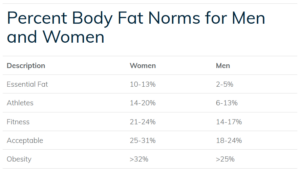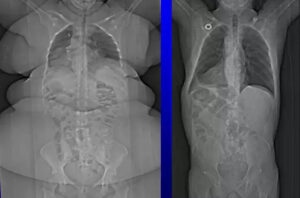How Much Body Fat is Acceptable?
If excess body fat is indeed a threat to our health, we should have an idea what amount of body fat is healthy or unhealthy. That sounds easy enough, but it’s not so clear.
Obesity is recognized as a significant risk factor in a plethora of metabolic diseases – diabetes, hypertension, heart disease, stroke, cancers, and more, but the definition of obesity has changed over time, from being a certain percentage overweight for a particular height to arbitrary percentages of body fat. The current definition of obesity relies on the Body Mass Index (BMI) – defined as one’s weight (in kilograms) divided by the square of one’s height (in meters) – with BMI over 30 describing obesity.
Enough about the BMI
If the categorization of obesity is about fat content, then we should not be using the BMI to diagnose obesity. BMI is notoriously inaccurate at capturing body composition and thus is not useful for characterizing the body fat status of individuals. Since muscle is more dense than fat, individuals with relatively high muscle mass are often inappropriately labeled “obese” by BMI criteria, despite having remarkably low body fat percentage. On the other extreme, many individuals with low or normal BMI have high amounts of body fat due to relatively low muscle mass.
If we were to accept the arbitrary World Health Organization standard of obesity defined as >35% in women and >25% in men, the BMI is a poor correlate. A BMI >30 overlooks nearly 50% of women with body fat >35%. Furthermore, the accuracy of the BMI detecting obesity by these body fat cutoffs are 94% for women and 82% for men.
A proposed guide to body fat percentages
Interestingly, there is no consensus on cutoffs for percentage body fat in adults. The American Council of Exercise appears to have the lone attempt at developing a table of standards for body fat percentage, with sex-specific criteria.

While there are attempts now to determine body fat correlates with BMI, it would be more helpful to determine cutoffs that are meaningful in terms of risk of disease or mortality outcomes. For example, when examining the correlation between body fat percentage and the presence of one of several cardiovascular risk factors, one study established cutoffs of 25.8% for men and 37.1%. It’s noted that cardiovascular risk factors appear at significantly lower body fat percentages in men compared with women.
However, there is an important barrier to establishing meaningful cutoffs for body fat – the Personal Fat Threshold that varies considerably among individuals. Individuals with high personal fat thresholds – with bodies that tolerate a large amount of subcutaneous fat storage – are less likely to develop visceral fat and thus would be expected to have relatively low rates of mortality despite a high body fat percentage. Individuals with low personal fat thresholds – with bodies that do not tolerate much subcutaneous fat storage – would theoretically be at a profoundly increased risk of mortality at the same high body fat percentage, because much of that fat mass would be visceral fat.
barrier to establishing meaningful cutoffs for body fat – the Personal Fat Threshold that varies considerably among individuals. Individuals with high personal fat thresholds – with bodies that tolerate a large amount of subcutaneous fat storage – are less likely to develop visceral fat and thus would be expected to have relatively low rates of mortality despite a high body fat percentage. Individuals with low personal fat thresholds – with bodies that do not tolerate much subcutaneous fat storage – would theoretically be at a profoundly increased risk of mortality at the same high body fat percentage, because much of that fat mass would be visceral fat.
My proposal for a new health indicator
Perhaps, then, a more meaningful measure of obesity and health status would be the proportion of one’s personal fat threshold that is occupied by one’s current fat stores, perhaps expressed as a percentage. Values of 100% or more of one’s personal fat threshold would indicate significantly increased risk of metabolic disease, indicative of the metabolic implications of visceral fat accumulation. While visceral fat (VAT) mass itself could be a helpful measure as well, it would be preferable to know well in advance at what point one was likely to see an increase in visceral fat. The problem, of course, with this measure is that it there is no easy way to determine one’s personal fat threshold . . . that we know of.
It’s all about the context
As with many things in medicine, it is impossible to understand the relevance of body fat percentage without the context of one’s overall health. We will most certainly continue relying on the overly simplistic BMI to diagnose obesity, due to its ease of use, and it will continue to be irrelevant to many people. If, however, we want measures of obesity that have significance to a wider range of people, then we must acknowledge the range of personal fat thresholds.





